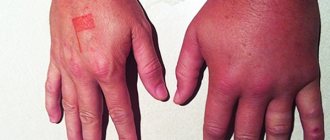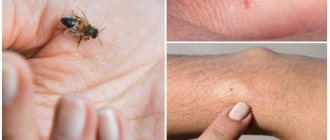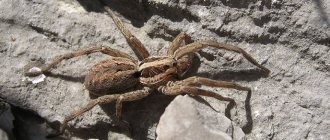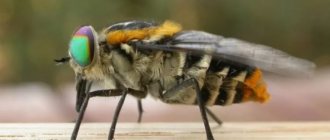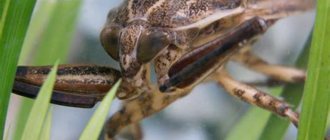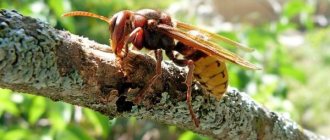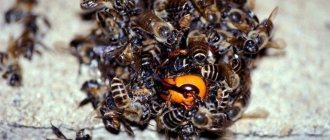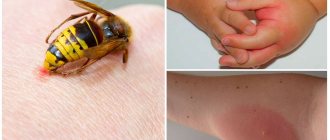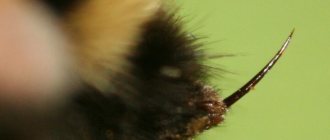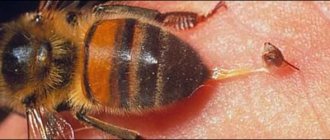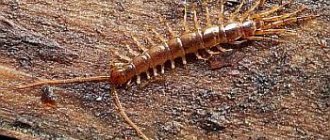An incredibly painful hornet sting will be remembered for a lifetime, but this is not the worst thing. It is life-threatening due to its toxic effects. To protect yourself and your loved ones from the consequences of an attack, it is important to learn the basic rules of first aid.
Unfortunately, few people know that the hornet is one of the most dangerous insects to humans. Unlike a bee, which stings only once, a hornet, like a wasp, can attack several times. And then, only adequate medical care can save the victim from death.
Who are hornets
What a hornet looks like and how painful its bite is is known to those who accidentally disturbed a wild insect in its shelter. The hornet is a hymenopteran predatory insect, the largest representative of the wasp family. The body length of an adult is from 2 to 2.5 cm, with the length of the uterus reaching 3.5 cm.
Unlike the thin wasp, the hornet has a more rounded abdomen and a larger crown of the head. Another important sign: brown-red color of the chest. In other representatives this part of the body is painted black. Basis of diet: flies, aphids, flower nectar or juice of various fruits. As a rule, stinging insects live in sun-warmed forest glades, gardens, and suburban areas.
Help: A hornet's nest can be found in any secluded place protected from bad weather: in a bush, in firewood, on a tree, under the roof of a house, on an open summer veranda. A swarm can contain up to 1 thousand individuals.
There are several dozen species of insects that live in different parts of our planet. The most common are: Japanese hornet, oriental, common, lamentable, Dybovsky, Asian.
Types of hornets and their lifestyle
Tireless builders construct cocoon-like nests from pieces of tree bark. Then the insects hang them in places protected from wind or rain: in attics, in the crown of trees, in a woodpile, etc. In such houses, the female lays eggs, and the remaining adults obtain food for the fast-growing offspring.
Since colonies of predators can be located in the most unexpected places, being outside the city, you need to be more careful. The hornets themselves are not aggressive and do not attack first. However, any sudden movement near the nest or its destruction signals danger and stimulates the production of an alarm pheromone, which determines the behavior of the entire swarm.
Asian hornet nest
Asian species are especially dangerous to humans, the bites of which are almost always fatal. The length of adult individuals reaches up to 5.5 cm, and the poison in the sting is highly toxic.
The bite of the European hornet, which lives on the territory of the Russian Federation, is more harmless and leads to the development of fatal complications only in the case of a rapid allergic reaction and the absence of timely anti-shock therapy.
Interesting fact: , from 70 to 100 people die from a hornet sting This fatality rate is much higher than the mortality rate from attacks by wild animals.
How and with what does a hornet bite?
The method of destruction cannot be called a bite, because the insect does not bite, but stings. Powerful, developed jaws are designed for obtaining food: small midges, arthropods. The expression “the hornet strikes” is not without meaning, because when approaching the victim, the insect does not sit on the surface of the skin, but sticks its sting with lightning speed, literally on the fly, bending in a special way. After injecting the poison, the hornet removes its sting.
The sting, designed to protect against attacks from enemies, is located at the bottom of the abdomen, and only in females. It does not have serrations, like bees, which means it is suitable for repeated attacks. If a person does not threaten the peace of a swarm or an individual, he is safe.
But in case of sudden movements, attempts to kill an insect or catch it, it will not only sting the offender, but will also send a signal to the rest of the inhabitants of the nest. The fact is that during the insertion of the sting, pheromones begin to be released, signaling danger. Having received the signal, a whole flock of hornets, capable of biting to death, flies to the aid of their relative.
Asian huge hornet on a man's hand.
It is impossible to avoid a hornet attack, because the insect, which has an unusually fast reaction, stings from any position. If a person's face is hidden by a mosquito net, the hornet sprays poison, leaving severe burns on the skin and mucous membranes.
Hornet - general information
The hornet looks more like a wasp than a bee. The size will help you not to confuse it with the first one. The insect is quite large and can reach a length of 55 mm. But most often in Russia, Ukraine and European countries, the common hornet is found, the size of which on average is 2 - 2.5 cm . Uteri are usually larger and can reach 3.8 cm in length and weigh 200 mg.
Insects build nests. Most often they are located on the edges of forests in well-lit places. However, you can also find a nest in the countryside, under the roof of a house or barn, on the branches of a garden tree, or in firewood.
The hornet, which can be seen in the photo, is a hunter, unlike a bee. The latter obtains food for itself by collecting nectar from flowers. Insects become the giant's victims. Its sting is a weapon, not a means of defense, like a bee's. This is why a bee dies after a sting, leaving its sting to the victim along with a sac of poison, and a hornet can inflict many stings .
Common hornet (photo)
Hornets, like wasps, can feed on overripe fruits. Therefore, you should be very careful when picking up fallen apples and pears in orchards.
What is the characteristic of a hornet bite?
It is almost impossible to die from one bite of a European hornet. However, the complex chemical composition of the poison entering the victim’s body causes a number of negative reactions. As a rule, the insect infects open areas of the body or face.
When the sting is inserted, the insect injects 0.5-2.0 mg of poison into the wound, causing an acute negative reaction in the victim’s body.
Note ! If you are bitten on the face, immediate help is especially important - toxic substances reduce visual function. The swelling quickly grows to the point where the eyes become impossible to open.
If the hand is injured, it is impossible to move your fingers. If there is a leg, the person is unable to walk due to pain.
The appearance of urticaria is a harbinger of Quincke's edema. Tumors that occupy large areas grow within an hour and do not subside within 10–48 hours. This complication is very dangerous, since swelling of the larynx makes breathing difficult and can lead to suffocation.
A hornet bite can be identified by the following signs:
- the bite site looks swollen, increasing several times, swells, turns red;
- the site of penetration of the sting is unbearably painful and itchy;
- heart rate increases;
- body temperature rises;
- dizzy;
- lymph nodes enlarge;
- inflamed ulcers form on the skin;
- blood pressure drops sharply.
If a person has a tendency to allergic reactions, the following are added to the above symptoms:
- nausea, sometimes vomiting;
- confusion of speech;
- hands and feet become cold;
- clouding of consciousness;
- in some cases, blueness of the neck, eyelids, lips, and ears is observed;
- soft tissues swell, attacks of suffocation appear;
Red rashes and peeling appear on the skin.
What happens if a hornet bites - symptoms
Swelling, redness, itching, and burning are observed at the site of the lesion. The damaged area is very itchy. If the wound is located near the lymph nodes, lymphadenitis or lymphangitis may develop. Characteristic symptoms of intoxication may appear - weakness, nausea, vomiting, fever, dizziness, persistent headache. After a hornet bite to the head or neck area, there is a possibility of loss of consciousness and convulsive seizures. If an insect stings a finger or toe, the entire limb may swell.
Immediately or some time after being bitten by a hornet, allergic symptoms may appear. The most typical symptoms are rash, burning, itching, swelling of the eyelids, larynx and soft tissues, and redness of the eyes. In severe cases, bronchospasm, Quincke's edema, and anaphylactic shock develop. Chest tightness and nausea can occur not only due to poisoning, but also due to allergies.
Hornet venom and its effect on the body
The poisonous substance injected by the hornet under the skin of the victim is protective in nature, which explains the painfulness of the bite. The components that make up the poison are found in rattlesnakes and other representatives of the animal world. The most dangerous components include:
- Acetylcholine. Activates nerve endings. Once in the tissue, it leads to irritation of nerve nodes, the occurrence of impulses and severe pain in the affected area.
- Phospholipase A2. A combination of enzymes that destroy cell walls. This substance is similar to a component of snake venom. Leads to vascular damage, hemorrhage, and the formation of suppuration.
- Orientotoxin. Dissolves cell membranes, allowing their contents to exit into the intercellular space. Destroys cellular structures.
- Histamine. Activates a rapid allergic reaction.
- Mastoparan. Releases histamine.
- Mandorotoxin. Blocks the functions of the nervous system.
- Biogenic amines. They provoke disruptions in the functioning of the respiratory and cardiovascular systems. Cause arrhythmia and difficulty breathing.
The remaining components act as catalysts, enhancing the reaction of tissues, accelerating the process of distribution of toxic substances.
Stung by a hornet: what to do?
First aid when at least one of the symptoms appears is as follows.
- First, the affected area of skin is carefully examined. It is rare, but it happens that a hornet leaves a sting in the body. This happens when the insect is swatted during contact with the body. The sting is carefully removed with disinfected tweezers or a needle.
- The wound itself is treated with a cotton swab soaked in hydrogen peroxide and a weak solution of potassium permanganate. If you don't have these products on hand, you can simply rinse with cold, clean water.
- Ice, a cold compress, a plastic bottle of water, frozen meat in a bag, and a cold heating pad are applied to the puncture site to slow down the spread of toxins in the body.
- A saturated saline solution and crushed aspirin tablet are applied to the bite site to relieve itching. For the same purposes, fresh cucumber, parsley or dandelion juice, cabbage or plantain leaves are used.
- Suprastin, Diphenhydramine, Pipolfen or another antihistamine is taken orally.
- Provide plenty of fluids.
- To relieve swelling and swelling, the skin is lubricated with hydrocortisone ointment or cream containing lidocaine.
Attention! Damage to the mucous membrane of the mouth and throat requires an immediate call to the ambulance and in-hospital therapy, which boils down to the introduction into the body through a dropper of solutions that promote the rapid elimination of poisons. Untimely assistance after a hornet sting or poor quality treatment can lead to disastrous results.
Actions to take if bitten at home
If you are bitten by a hornet, there is no need to panic, as this will only intensify the negative reaction of the body, which will immediately affect the condition of the victim. The most important thing is to stop the allergic reaction as soon as possible.
Severe symptoms of intoxication can greatly frighten the victim, especially a child. However, you should not lose your presence of mind. It is important to remember that timely and competent first aid will help to avoid the development of dangerous consequences of a bite.
First aid
When stung by a hornet, it is important to remember that the condition of the victim depends on how competently first aid was provided to him. Here are the main recommendations from experts:
- Help the victim move away from the site of the insect attack, sit him in a comfortable position, loosen tight-fitting clothing: belt, cuffs, collar.
- Inspect the site of the bite. If the hornet was killed during an attack, fragments of the sting may remain in the wound. They must be removed using tweezers treated with alcohol.
- Try to suck out the venom as soon as possible and then wash the bite area with cold water.
- Treat the affected area with a weak solution of potassium permanganate or other antibacterial agent.
- Wipe the bite area with an alcohol solution, eau de toilette or vodka.
- Apply a tight bandage just above the source to prevent the poison from spreading throughout the body. It is removed after 30 minutes.
- Apply an ice compress or just something cold.
- To prevent the development of an allergic reaction, give the victim an antihistamine.
- Provide the victim with plenty of drinking water, preferably non-carbonated mineral water.
- If an allergy does appear, take the victim to the nearest medical facility or call an ambulance.
When treating the bite site, you need to act very gently and delicately, barely touching the skin.
ethnoscience
When going out into nature, few people care about putting antihistamines or painkillers in the first aid kit. And then, to combat the consequences of a hornet bite, time-tested traditional medicine is used:
- A paste of fresh leaves of parsley, aloe or plantain will help relieve inflammation and slow down the spread of swelling.
- To relieve pain, apply a mixture of vinegar and dandelion juice to the bite site. A slurry made from crushed acetylsalicylic acid tablets, soda and water has a similar effect.
- A paste of fresh potatoes or cucumber will help relieve inflammation.
- To delay the hornet's venom at least a little, apply a damp piece of sugar to the bite site for 5-10 minutes.
Before using any folk remedy, the bite site must be thoroughly washed. After applying the product, cover the treated area with a clean natural cloth. Compresses need to be changed every 20 minutes.
Information for allergy sufferers
The hornet is especially dangerous for people with allergies, because the histamine contained in the insect's venom accelerates the development of an allergic reaction. Therefore, when leaving the confines of their home, people prone to allergic reactions should carry antihistamines and sorbents that accelerate the removal of toxins from the body.
It is also necessary to issue a special medical passport, which contains all the information about the drugs used and the effect of the body on them. And when going outdoors, it is important to inform your surroundings about a possible allergy to insect bites.
Medicines for allergic reactions:
- Citrine;
- Suprastin;
- Claritin;
- Erius;
- Loratadine;
- Fexofenadine.
External means:
- Fenistil-gel;
- Balm “Rescuer”;
- Psilo-balm.
To reduce the concentration of poison, sorbents are used:
- Polysorb;
- Smecta;
- White coal;
- Enterosgel.
First aid after a bite
First aid after a bite
If a large black-striped wasp attacks a person, then it is necessary to provide him with first aid as soon as possible in case of a hornet bite:
- Move with the victim away from the site of the insect attack, sit down and loosen tight-fitting clothing (collar, belt, etc.).
- Visually inspect the affected area for any remaining sting and remove it from the skin using tweezers.
- Try to suck the poison out of the wound as quickly as possible.
- Rinse the area with cold water, treat and disinfect with alcohol, potassium permanganate solution or soap, wiping with a cotton swab to remove pathogenic bacteria.
- You can apply a damp lump of sugar, which will help partially draw off the toxic liquid, but no more than 10 minutes.
- To neutralize the toxic poison, acids in the form of squeezed lemon, onion, cucumber or acetylsalicylic acid are used for processing.
- Applying ice or frozen food wrapped in plastic will help numb the tissue.
- Give a person an antihistamine when determining an allergic reaction: Loratadine, Dexamethasone, Suprastin, etc.
- If the bite occurs in the throat or mouth, then it is necessary to consult a doctor, as breathing problems are possible;
- Seek help from specialists if the condition is alarming.
Why is a hornet sting dangerous for humans?
For a healthy person not predisposed to allergies, the maximum danger is posed by more than 20 bites at a time. Almost 96% of victims experience negative reactions from the body. For the remaining 4%, the hornet bite passes without consequences.
At risk:
- allergy sufferers who may develop severe allergic reactions leading to swelling of the larynx and death. However, such complications arise only when the victim does not receive qualified first aid;
- persons subjected to repeated insect attacks - the consequences will be more severe than the first time;
- a strong negative reaction is observed if the victim is a child with an unformed immune system;
- if the hornet stings the head, neck or the area where large vessels and arteries pass.
Consequences of a hornet sting
The body's reaction depends on the age and physical fitness of the victim, the presence of chronic pathologies, his predisposition to allergies and the number of bites.
If special first aid measures have not been taken, the danger lies in the development of the following consequences:
- infection and suppuration of the bite site;
- multiple hemorrhages, which is especially likely with multiple bites;
- local tissue necrosis;
- renal failure;
- heart failure;
- in case of individual intolerance to poison - anaphylactic shock;
- death.
Symptoms and consequences of a hornet sting
What a hornet bite looks like - in the photo
First of all, remember what is necessary in any emergency situation is not to panic. Because in this case a person will make a lot of mistakes. Be prepared for severe pain after the bite. The reason is that hornet toxins contain elements that can adversely affect the human nervous system. This is why a person can even go into shock from a hornet sting.
The difficulty of a hornet sting is that it is impossible to predict its consequences, since the reaction varies from person to person. For some, it all ends only with pain and swelling, for others, they may lose consciousness, and for a third, suffocation may result in death. Here it is also necessary to take into account whether a person has ever been bitten by a hornet, a bee or a wasp, since this factor can also aggravate the situation. Inaction when bitten is highly discouraged.
Preventing hornet bites
To protect yourself from attacks by poisonous insects, just follow the recommendations:
- When choosing a place for a picnic, first inspect the green spaces to identify insect nests.
- Avoid sudden movements when noticing stinging insects.
- If you find a nest, do not try to knock it down with a stick or destroy it.
- Do not knock on a tree or roof if you find a nest there.
- Stay away from that nest location.
- When going out of town, do not wear perfumes with floral or fruity scents.
How to behave when surrounded by Hymenoptera?
There are situations when arriving at a dacha or in the forest confronts people with the fact that after their long winter absence, this territory is already occupied by wasps or hornets. In mid-April, the female begins to build her nest, designating the habitat in this area. If time is lost, the hornets have seriously and permanently settled on the site, you need to choose the right behavioral tactics to avoid a hornet bite.
If you are bitten by a hornet, take an antihistamine
- Under no circumstances should you touch a nest that is found in the yard, hanging from the branches or located under the roof, or even approach it, not to mention stirring it with a stick. Angry insects will immediately rush towards the offender.
- You need to behave calmly and not provoke the “big wasps” to attack with sudden movements.
- An insect that lands on the body should not be killed. Firstly, you can get a portion of poison. Secondly, the enzyme secreted by hornets in case of danger serves as an alarm signal for relatives who immediately rush to help.
- When traveling outside the city, wear comfortable clothing, without bright colors, that protects the body, and closed shoes. Avoid perfumes with a strong smell.
- If, nevertheless, a decision is made to get rid of the hornets on the site and from the nest first, this should be done in overalls that cover the body and gloves. Pay special attention to protecting the head, face, and eyes in particular. There have been cases when, through a mosquito protective net, the poison shot from the sting penetrated the mucous membrane of the eye and caused a burn to the retina.
- Having picked an apple or pear from a branch, the fruit must be carefully examined before washing and biting. You can often find a hornet hidden in the ripe pulp.
Tactful behavior towards these highly organized insects will yield results. Some people live peacefully with hornets for years. In response to this, the striped “hard workers” protect their crops from garden pests, catching them and feeding them to the larvae. If such a nuisance as a hornet bite does happen, you need to be prepared to neutralize the unpleasant consequences.
Source
